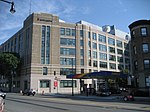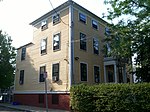Whirlwind I

Whirlwind I was a Cold War-era vacuum tube computer developed by the MIT Servomechanisms Laboratory for the U.S. Navy. Operational in 1951, it was among the first digital electronic computers that operated in real-time for output, and the first that was not simply an electronic replacement of older mechanical systems. It was one of the first computers to calculate in parallel (rather than serial), and was the first to use magnetic-core memory. Its development led directly to the Whirlwind II design used as the basis for the United States Air Force SAGE air defense system, and indirectly to almost all business computers and minicomputers in the 1960s, particularly because of the mantra "short word length, speed, people."
Excerpt from the Wikipedia article Whirlwind I (License: CC BY-SA 3.0, Authors, Images).Whirlwind I
Massachusetts Avenue, Cambridge Cambridgeport
Geographical coordinates (GPS) Address Nearby Places Show on map
Geographical coordinates (GPS)
| Latitude | Longitude |
|---|---|
| N 42.361666666667 ° | E -71.096666666667 ° |
Address
Massachusetts Avenue 209;211
02238 Cambridge, Cambridgeport
Massachusetts, United States
Open on Google Maps








